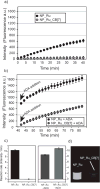Supramolecular regulation of bioorthogonal catalysis in cells using nanoparticle-embedded transition metal catalysts
- PMID: 26100809
- PMCID: PMC5697749
- DOI: 10.1038/nchem.2284
Supramolecular regulation of bioorthogonal catalysis in cells using nanoparticle-embedded transition metal catalysts
Abstract
Bioorthogonal catalysis broadens the functional possibilities of intracellular chemistry. Effective delivery and regulation of synthetic catalytic systems in cells are challenging due to the complex intracellular environment and catalyst instability. Here, we report the fabrication of protein-sized bioorthogonal nanozymes through the encapsulation of hydrophobic transition metal catalysts into the monolayer of water-soluble gold nanoparticles. The activity of these catalysts can be reversibly controlled by binding a supramolecular cucurbit[7]uril 'gate-keeper' onto the monolayer surface, providing a biomimetic control mechanism that mimics the allosteric regulation of enzymes. The potential of this gated nanozyme for use in imaging and therapeutic applications was demonstrated through triggered cleavage of allylcarbamates for pro-fluorophore activation and propargyl groups for prodrug activation inside living cells.
Figures





Comment in
-
Bioorthogonal catalysis: Rise of the nanobots.Nat Chem. 2015 Jul;7(7):538-9. doi: 10.1038/nchem.2291. Nat Chem. 2015. PMID: 26100798 No abstract available.
Similar articles
-
Degradable ZnS-Supported Bioorthogonal Nanozymes with Enhanced Catalytic Activity for Intracellular Activation of Therapeutics.J Am Chem Soc. 2022 Jul 20;144(28):12893-12900. doi: 10.1021/jacs.2c04571. Epub 2022 Jul 5. J Am Chem Soc. 2022. PMID: 35786910
-
Polymer-Based Bioorthogonal Nanocatalysts for the Treatment of Bacterial Biofilms.J Am Chem Soc. 2020 Jun 17;142(24):10723-10729. doi: 10.1021/jacs.0c01758. Epub 2020 Jun 8. J Am Chem Soc. 2020. PMID: 32464057 Free PMC article.
-
Designed heterogeneous palladium catalysts for reversible light-controlled bioorthogonal catalysis in living cells.Nat Commun. 2018 Mar 23;9(1):1209. doi: 10.1038/s41467-018-03617-x. Nat Commun. 2018. PMID: 29572444 Free PMC article.
-
Modular Fabrication of Bioorthogonal Nanozymes for Biomedical Applications.Adv Mater. 2024 Mar;36(10):e2300943. doi: 10.1002/adma.202300943. Epub 2023 Oct 18. Adv Mater. 2024. PMID: 37042795 Free PMC article. Review.
-
Transition metal catalysts for the bioorthogonal synthesis of bioactive agents.Curr Opin Chem Biol. 2021 Apr;61:32-42. doi: 10.1016/j.cbpa.2020.10.001. Epub 2020 Nov 2. Curr Opin Chem Biol. 2021. PMID: 33147552 Review.
Cited by
-
Creating a suprazyme: integrating a molecular enzyme mimic with a nanozyme for enhanced catalysis.Chem Sci. 2024 Sep 26;15(40):16480-4. doi: 10.1039/d4sc04577g. Online ahead of print. Chem Sci. 2024. PMID: 39371455 Free PMC article.
-
In situ reversible tuning of chemical interface damping in single gold nanorod-based recyclable platforms through manipulation of supramolecular host-guest interactions.Chem Sci. 2021 Apr 15;12(20):7115-7124. doi: 10.1039/d1sc01204e. Chem Sci. 2021. PMID: 34123339 Free PMC article.
-
Dipeptide coacervates as artificial membraneless organelles for bioorthogonal catalysis.Nat Commun. 2024 Jan 2;15(1):39. doi: 10.1038/s41467-023-44278-9. Nat Commun. 2024. PMID: 38169470 Free PMC article.
-
DNA-based platform for efficient and precisely targeted bioorthogonal catalysis in living systems.Nat Commun. 2022 Mar 18;13(1):1459. doi: 10.1038/s41467-022-29167-x. Nat Commun. 2022. PMID: 35304487 Free PMC article.
-
eg occupancy as an effective descriptor for the catalytic activity of perovskite oxide-based peroxidase mimics.Nat Commun. 2019 Feb 11;10(1):704. doi: 10.1038/s41467-019-08657-5. Nat Commun. 2019. PMID: 30741958 Free PMC article.
References
Publication types
MeSH terms
Substances
Grants and funding
LinkOut - more resources
Full Text Sources
Other Literature Sources

